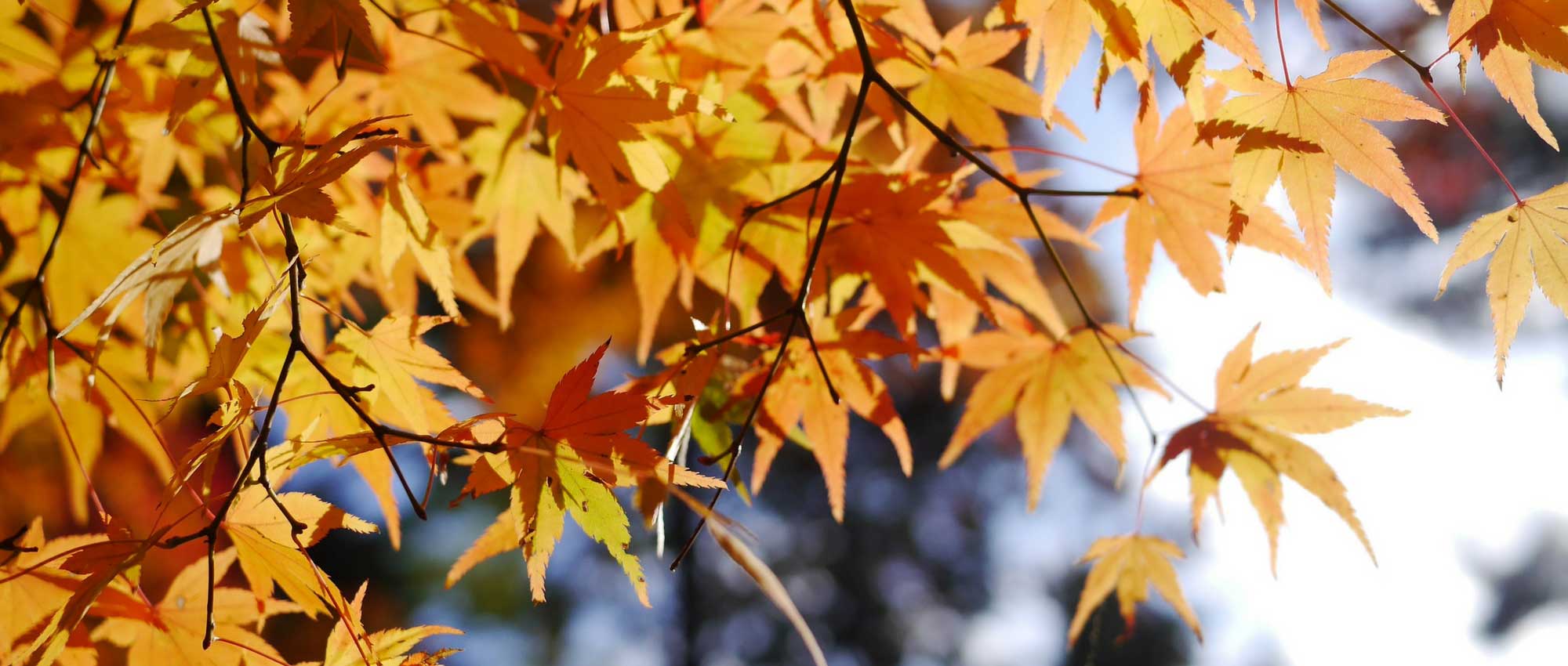
Japanese maple: planting, pruning and care
Contents
Japanese Maple in a nutshell
- The Japanese maple is an elegant bush, with a perfect structure and incredible graphics!
- Its finely dissected foliage takes on stunning hues in autumn.
- It is a key element in Japanese gardens or zen gardens.
- Japanese maples are perfect for small gardens and can even be grown in containers!
- They look beautiful when isolated, highlighting their impeccable silhouette.
- They thrive in partial shade, in cool, well-drained soil, and should be sheltered from the wind.
A word from our Expert
Japanese maples are small trees or bushes which foliage, palmate and divided, changes colour throughout the seasons, taking on magnificent hues in autumn! They mainly include Acer palmatum and Acer japonicum, as well as the many varieties that stem from them. It is possible to grow them in pots, and even to prune them to create bonsais! They possess foliage that surprises us with its incredible fineness, which often ignites in autumn, just before disappearing for winter! Their colours, often purple, red or orange, catch the eye in the garden. They illuminate dark corners and play with the light. When planted alone, their graphic silhouette impresses by revealing a true natural elegance. The different varieties have foliage that is more beautiful than the others, offering real diversity in terms of shapes and colours!
Japanese maples are quite demanding bushes that need to be grown in ideal conditions to reveal their full potential: partial shade, soil that is necessarily cool and draining, porous, and slightly acidic substrate… Once established, maintenance will be limited to a few waterings during dry periods (except in the case of pot cultivation, where watering will need to be more regular), and occasionally adding compost and mulch at their base. It is especially important to be vigilant regarding diseases, such as verticillium wilt, which can cause serious damage. Unless you wish for a specific training, such as bonsai or niwaki, the Japanese maple can very well do without pruning. These are small trees that grow slowly, making them particularly suited for small gardens or container cultivation. This bush, ideal for city gardens, pairs wonderfully with ferns and grasses. It fits perfectly into the composition of a Japanese-inspired zen garden.
Botany
Botanical data
- Latin name Acer palmatum, Acer japonicum
- Family Sapindaceae
- Common name Japanese Maple
- Flowering between April and June
- Height up to 10 metres
- Exposure partial shade
- Soil type rich, rather acidic, cool and well-drained
- Hardiness generally between -15 and -20 °C
The Japanese maples are stunning trees or bushes with deciduous foliage. In France, there are 9 species of maples, but there are between 110 and 160 worldwide. Japanese maples mainly include the species Acer palmatum, Acer japonicum, and Acer shirasawanum, along with the hundreds of varieties derived from them. The Acer palmatum originates from China, Korea, Japan, and Taiwan, while Acer japonicum and Acer shirasawanum are primarily found in Japan. The Acer palmatum can be found at altitudes of up to 1,000 metres, mainly in forests and wooded areas.
Maples now belong to the family Sapindaceae, but they previously had their own family, Aceraceae. The Sapindaceae family includes thousands of species (mostly trees and bushes), including the Horse Chestnut (Aesculus hippocastanum) and Lychee.
Japanese maples have a very beautiful, rather rounded architecture, yet always extremely graphic. They grow slowly, making them suitable for small gardens or container cultivation, but they can still become quite large. Most Japanese maples can reach a maximum height and spread of 10 metres. However, some can grow up to 15 metres tall in their natural state. Their trunks are generally ramified from the base. Their slow growth and superb architecture make them excellent candidates for bonsai training. The branches are flexible, sometimes trailing, giving them an almost weeping habit, or dome-shaped, as seen in Acer palmatum ‘Dissectum Garnet’. The Acer palmatum ‘Sangokaku’ surprises us with its stunning bright red branches.

The elegant silhouette of the Japanese Maple! Here, Acer palmatum ‘Osakazuki’ (photo Kloniwotski)
Japanese maples have exceptional foliage, offering endless shades, both in form and colour! It changes throughout the seasons, taking on beautiful hues in autumn. It is deciduous, thus disappearing for the winter. The leaves are opposite, arranged face to face on the branches.
The foliage of maples is palmate. This is actually what gave the species its name, Acer palmatum. The Acer shirasawanum has leaves with very rounded edges. The foliage is always very graphic and sometimes delicately cut! The Acer palmatum ‘Dissectum’ is undoubtedly the one with the finest leaves.
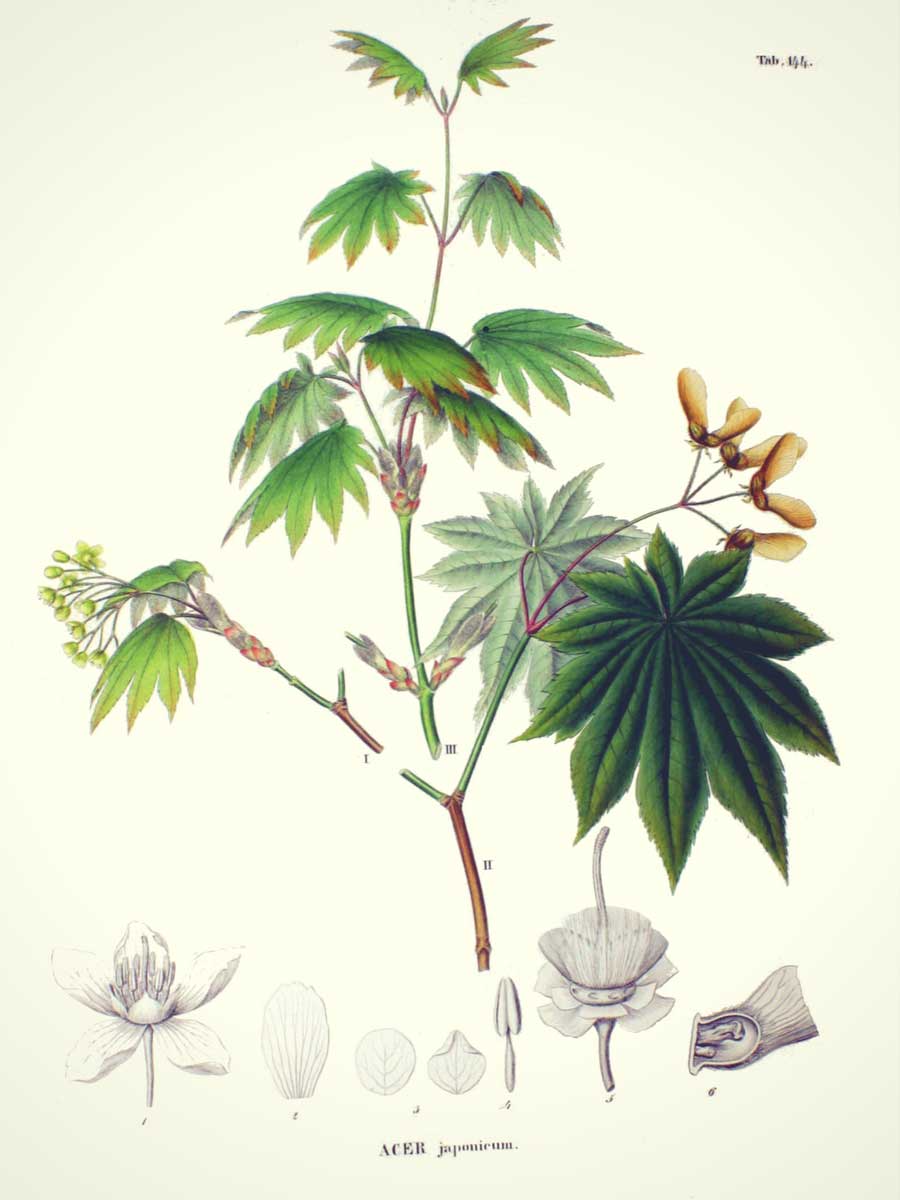
Acer japonicum: botanical plate
The leaves of Japanese maples often measure between 5 and 10 centimetres long, but depending on the varieties, they can vary in size. For instance, the Acer palmatum ‘Butterfly’ has small leaves measuring only 3 to 5 centimetres in length, while those of the ‘Osakazuki’ variety are much larger, reaching between 10 and 15 centimetres long.
Maples offer great variability in leaf shape: from the just lobed foliage of the Acer shirasawanum ‘Aureum’ to the finely cut foliage of the Acer palmatum ‘Dissectum’, including the Aconit-leaved Maple (Acer japonicum ‘Aconitifolium’)! The leaves typically have an odd number of lobes, often between five and seven, but sometimes up to eleven, particularly in Acer japonicum or Acer shirasawanum.
In terms of colours, the diversity is equally exceptional: from the golden foliage of the Acer shirasawanum ‘Aureum’ to the darkest foliage, like that of the ‘Bloodgood’ variety, passing through very bright and tangy shades: ‘Orange Dream’ or ‘Sangokaku’… There is even a maple with variegated foliage, edged in cream or pink: Acer palmatum ‘Butterfly’. It is rare for trees or bushes to offer such diversity in their foliage colours!
The foliage of Japanese maples has the advantage of changing colour throughout the seasons! They often take on soft, sometimes tangy shades in spring (light green, pink, orange, lemon yellow), becoming slightly darker in summer, and ultimately literally igniting in autumn! Japanese maples offer a rainbow of colours, leaving no room for monotony.
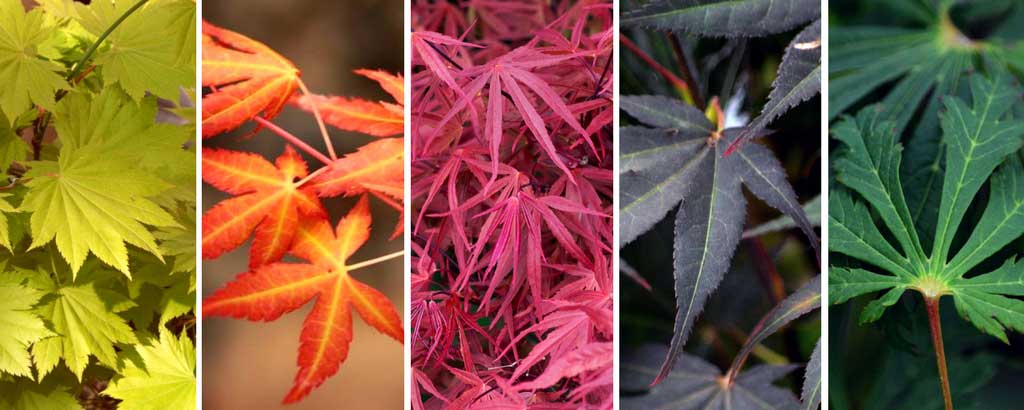
The leaves of Japanese maples offer a beautiful palette of colours! From left to right: Acer shirasawanum (photo André Abrahami), Acer palmatum ‘Orange Marmalade’, Acer palmatum ‘Red Pygmy’, Acer palmatum ‘Atropurpureum’, and Acer japonicum ‘Aconitifolium’
They sometimes have very beautiful barks, as is the case with the Acer palmatum ‘Sangokaku’ and its bright red wood.
The Japanese maple flowers between April and June. The flowers are purplish-red and grouped in pendulous corymbs (except for Acer shirasawanum, where they are upright). They are rather discreet, as they are very small.
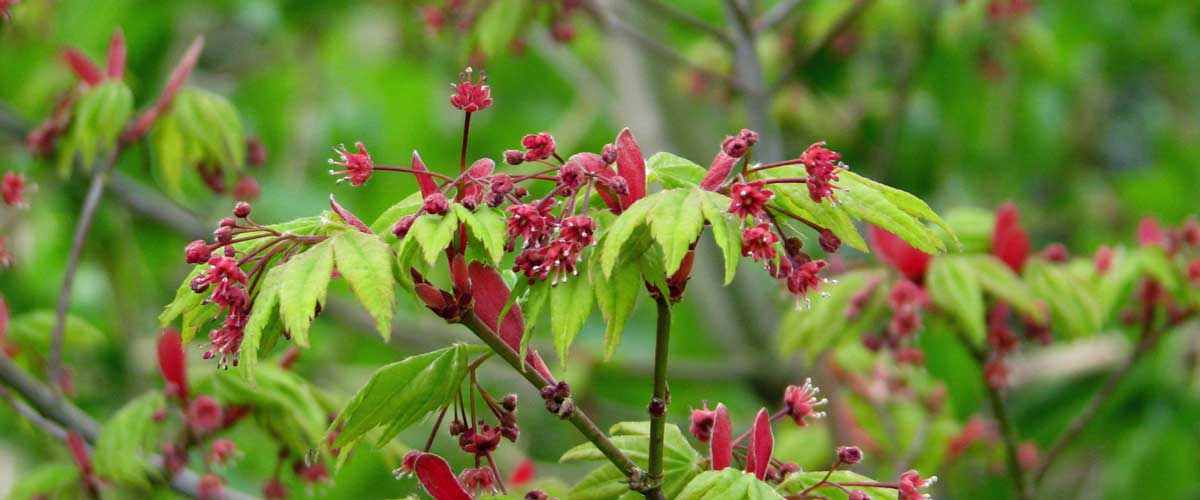
The flowering of Acer japonicum ‘Vitifolium’ (photo Peganum)
At the end of summer, Japanese maples bear decorative red fruits, known as samaras. They are also called disamarae since they consist of two seeds glued together, each with a wing. This pair of seeds and wings can travel great distances when carried by the wind.
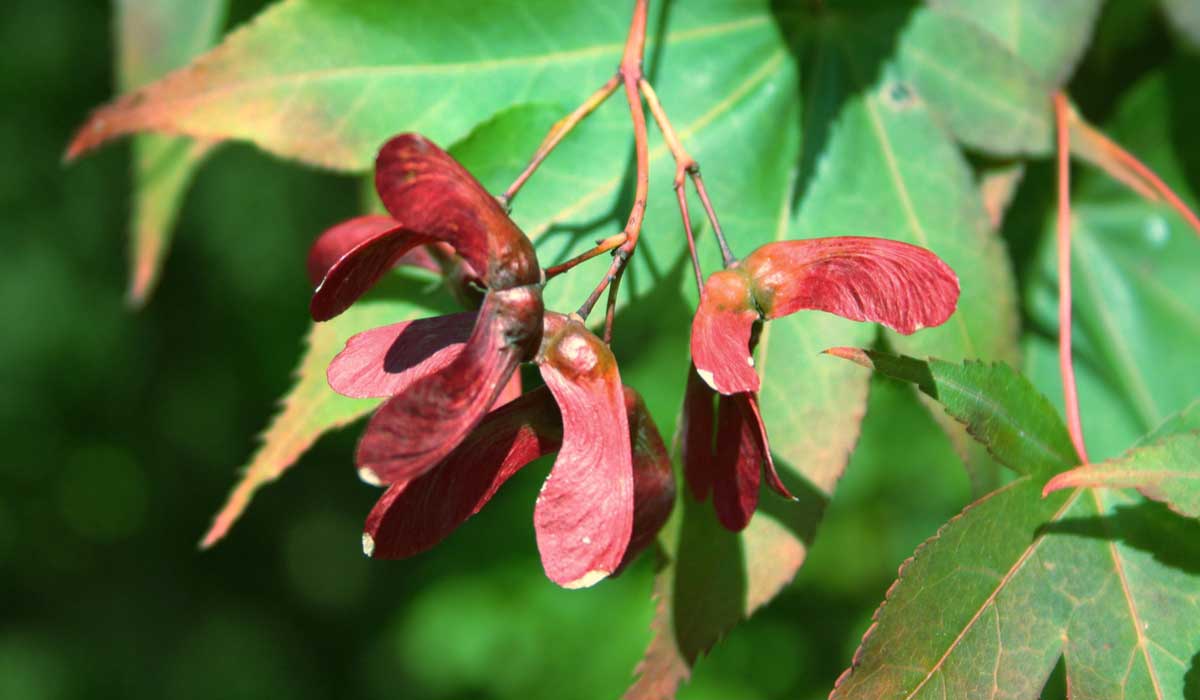
The samaras of Acer palmatum ‘Osakazuki’ (photo Jean-Pol Grandmont)
The Japanese maple has fibrous and rather shallow roots. They tend to stay near the surface and do not appreciate competition with other plants. It needs space around it, and the soil should be worked over a good width. For container cultivation, a pot three to four times the width of the root ball is required.
The main varieties of Japanese Maples
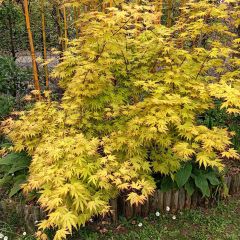
Acer palmatum Orange Dream - Japanese Maple
- Flowering time May, June
- Height at maturity 3 m
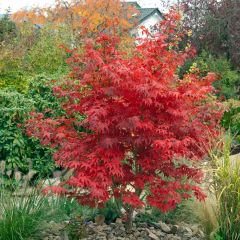
Acer palmatum Osakazuki - Japanese Maple
- Flowering time May, June
- Height at maturity 4 m
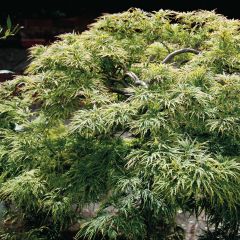
Acer palmatum Dissectum - Japanese Maple
- Flowering time May, June
- Height at maturity 1,60 m
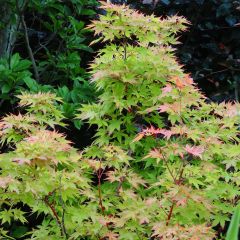
Acer palmatum Sangokaku - Japanese Maple
- Flowering time May, June
- Height at maturity 3 m
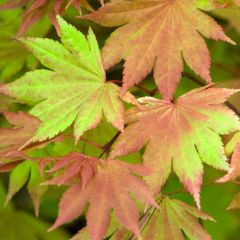
Acer shirasawanum Autumn moon - Japanese Maple
- Flowering time May, June
- Height at maturity 3 m
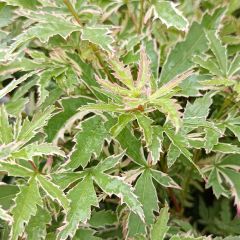
Acer palmatum Butterfly - Japanese Maple
- Flowering time May, June
- Height at maturity 2,50 m

Acer palmatum - Japanese Maple
- Flowering time May, June
- Height at maturity 6 m
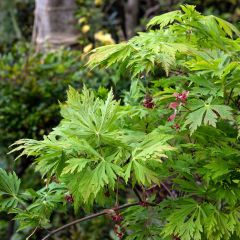
Acer japonicum Aconitifolium - Japanese Maple
- Flowering time May, June
- Height at maturity 3 m
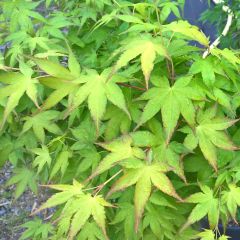
Erable du Japon ou Acer palmatum Aureum
- Flowering time April, May
- Height at maturity 2 m
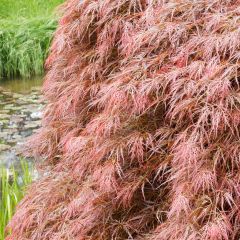
Acer palmatum Dissectum Garnet - Japanese Maple
- Flowering time May, June
- Height at maturity 3 m
Discover other Japanese Maples
View all →Available in 6 sizes
Available in 1 sizes
Available in 1 sizes
Available in 1 sizes
Available in 1 sizes
Available in 4 sizes
Available in 1 sizes
Available in 3 sizes
Available in 2 sizes
Available in 3 sizes
Planting Japanese Maple
Where to plant?
We recommend placing your Japanese maple in partial shade. Full sun may cause leaf burn during summer, while too dense shade would dull its colours, making them less spectacular in autumn.
Plant it in fresh, well-drained soil! Soil that retains water encourages the development of fungal diseases, such as verticillium wilt. If your ground is heavy and clayey, you will need to improve drainage by adding gravel or coarse sand during planting. Don’t hesitate to plant it on a mound or on sloping ground to promote water runoff.
The Japanese maple prefers slightly acidic soils. You can plant it alongside other ericaceous plants, such as azaleas, Japanese Andromeda (Pieris japonica), or daphnes.
Find a sheltered spot from cold or drying winds. Also, avoid planting it too close to other trees or bushes: it doesn’t really like competition at the root level…
It appreciates soils rich in organic matter. We recommend adding well-decomposed compost during planting.
Finding the ideal location for your Japanese maple is very important. It is a delicate plant that will be more easily affected by diseases or pests if the conditions are not suitable. If your ground is not suitable for its cultivation, you can also plant it in a pot and place it on your terrace or in a patio.

Install your Japanese maples in partial shade. Here, Acer japonicum ‘Aconitifolium’ (photo Jean-Pol Grandmont)
When to plant?
Plant your Japanese maple preferably in autumn to give it time to settle in. In humid regions, however, favour planting in spring, around March-April.
How to plant?
- Place the root ball in a basin filled with water for about 15 minutes.
- Dig a planting hole three to four times the width of the root ball, as the root system of maples is shallow and tends to spread easily in width.
- Add well-decomposed compost, a bit of heather soil, and gravel or coarse sand for drainage.
- Plant your Japanese maple at collar level, ensuring not to bury the grafting point under the soil.
- Replace the soil around the root ball and gently firm it down.
- Water generously.
- Apply a mulch at its base to retain soil moisture during summer.
Don’t hesitate to grow your Japanese maple in a pot, choosing a sufficiently large container. Place a layer of gravel or broken pot at the bottom to allow for drainage. Then, install a substrate made of a mix of garden soil, well-decomposed compost, pine bark, and clay balls. Plant the bush, replace the substrate, then firm it down and water. Be vigilant about watering, as the substrate in pots dries out much faster than in open ground!
To successfully plant the Japanese Maple, whether in the garden or in a pot, discover our guides: “Japanese Maple: Successful Planting” and “Japanese Maple in a Pot: Choice, Planting, and Care” and Which Japanese Maples Can Be Grown in Pots?
Maintenance
Japanese maple is a delicate tree that is easily affected by diseases if not planted in suitable conditions. Care must be taken to ensure its longevity. As it prefers rich, light soils, it will appreciate an application of well-decomposed compost once a year. The leaves of maples are sometimes scorched by the sun in summer or by late frosts in spring. In colder regions, you can apply a layer of mulch around your maples in autumn to protect them from the cold, and if they are grown in pots, wrap a winter cover around them. We also recommend repotting your Japanese maples every two to four years. Do this at the end of winter, just before the start of growth.
Japanese maples need coolness, which is why it is important to water during summer and at each dry spell. However, the Japanese maple is sensitive to excess moisture, so it is essential to find the right balance and allow the soil to dry out between waterings! You will need to be especially vigilant about water shortages if you are growing them in containers. You can apply mulch to keep the soil cool. They require water, especially during the first few years. They become more resilient as they age. Avoid using hard water; instead, opt for rainwater. In summer, we recommend misting the foliage of your Japanese maple in the evening. This helps to cool it down and simultaneously prevents the appearance of red spider mites.
Japanese maples are very sensitive to verticillium wilt, a disease caused by a fungus that thrives in heavy, moist soils. The leaves wilt, the branches gradually dry out, and the tree often ends up dying. There is no treatment, only preventive measures, starting with drainage. For more information, check our article Japanese Maples, beware of verticillium wilt!
The Japanese maple is sometimes affected by coral disease (Nectria cinnabarina), a fungus that spreads and causes branches to die. It is characterised by the presence of orange pustules on the branches. Cut away the affected parts to limit the spread of the disease.
The Japanese maple is also susceptible to honey-coloured armillaria, Armillaria mellea, or honey fungus. This is also a fungus. It rots the roots and the base of the trunk, leading to rapid wilting of the leaves and death of the branches.
For all these diseases caused by fungi, it is necessary to prune the affected branches and burn them to limit their spread. Always remember to disinfect your cutting tools.
As for pests, the Japanese maple is sometimes attacked by defoliating caterpillars, which eat its leaves, significantly weakening it. Cut and burn the affected parts. In case of a severe infestation, you can prepare and apply a garlic decoction or treat with a product based on Bacillus thuringiensis. The Japanese maple can also be infested by mealybugs, identifiable by their white, cottony appearance, as well as by aphids (especially in spring, on the still young leaves). Mealybugs and aphids weaken the tree by extracting sap and secrete honeydew, which is conducive to the development of fungi, such as sooty mould. If you notice these insects on your maple, treat with a mixture of black soap, rapeseed oil, and 90° alcohol diluted in water. Against aphids, you can also use nettle manure. It also happens that maples are targeted by red spider mites. You can prevent them by regularly misting the foliage of your maple, which it will particularly appreciate.
To identify, prevent, and treat diseases and pests, discover our advice sheet: “Japanese Maples: diseases and pests”
If your Japanese maples are not affected by any disease, it is preferable not to prune them. This weakens them, and the wounds can serve as entry points for diseases like verticillium wilt. Japanese maples are slow-growing shrubs: pruning them could further slow their growth. Avoid intervening on young specimens; let your bush grow naturally for at least the first few years. If you wish to intervene on your maple to rebalance it or give it a nice shape, do so in winter (between November and February), when the shrub is in a dormant state, outside of frost periods. However, an exception: you can prune during the growing season to remove dead branches, as they are easier to spot then. Disinfect your tools to avoid transmitting diseases. We also recommend applying healing paste on the wounds.
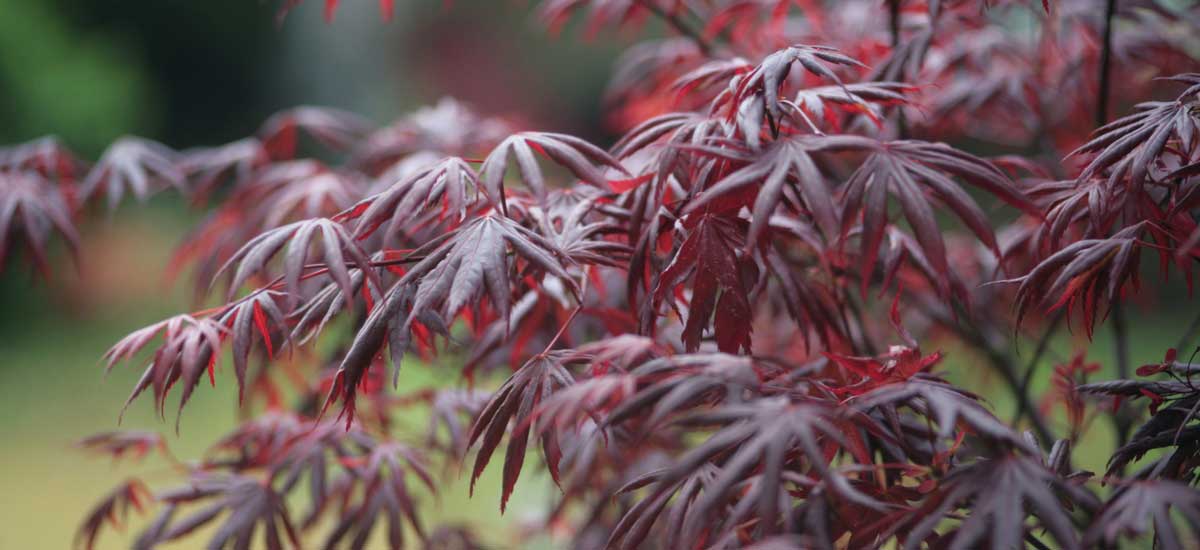
Acer palmatum ‘Trompenburg’
To learn everything about pruning the Japanese Maple, follow our advice: “Japanese Maple: maintenance pruning, in bonsai or niwaki”
Multiplication
It is possible to propagate Japanese maples by sowing, propagation by cuttings, or grafting. We recommend propagation by cuttings, which will ensure you obtain a plant that is strictly identical to the original variety. However, some varieties are difficult to propagate using this technique.
Sowing
Japanese maple seeds require a cold period to break their dormancy and thus germinate in spring. They need to be stratified by placing them in the refrigerator for a few months before they can be potted. Prefer sowing for typical species, such as Acer palmatum.
- Harvest the seeds in autumn.
- The seeds are attached to a wing. You may detach it to sow them more easily.
- Fill a tray with moist sand, then mix the seeds with the sand. Seal the tray in a plastic bag and place it in the vegetable drawer of the refrigerator for at least three months. You can also use an airtight box instead of the tray and plastic bag.
- When the seeds have started to germinate, take them out gradually to pot them up.
- Prepare pots with a mix of potting soil, sand, and a bit of heather soil.
- Pot up the young shoots into these pots.
- Water.
- Place your seedlings out of direct sunlight.
Propagation by Cuttings
You can propagate your Japanese maples by softwood cuttings in early summer, around June. However, some varieties are difficult to reproduce using this technique. The typical species, Acer palmatum, roots quite well.
- Fill a pot with a mix of potting soil and perlite or coarse sand, moisten it, and then gently firm it down.
- Make a hole with a pencil or a wooden stick.
- Take a healthy stem fragment from the current year, about 15 centimetres long. Cut just below a node (leaf bud), making a clean cut with a disinfected tool.
- Remove the leaves at the base of the cutting, leaving only two or three at the top.
- Optionally dip the base of the stem in water and then in rooting hormone to encourage rooting.
- Make a hole in the substrate with a pencil or a wooden stick, then place the cutting in it.
- Press the substrate around the stem to ensure good contact between the potting soil and the cutting, and to avoid air pockets.
- Place the pot in a bright location but out of direct sunlight, ideally at a temperature of 20-25 °C.
- Mist the cutting several times a day to prevent it from drying out. You can also place a plastic bag over the pots to maintain a humid atmosphere. It should be perforated, and you will need to remove it occasionally to prevent fungal growth.
- Water regularly. The substrate should be moist but not overly wet.
Grafting
The varieties of Japanese maples sold are often the result of grafting. Sowing does not guarantee obtaining a plant identical to the parents, and some varieties are very difficult to propagate by cuttings. Grafting remains the only effective solution for these varieties.
Intervene in late winter (February – March) or in July-August. Ideally, use Acer negundo or Acer palmatum as rootstock. Choose the variety you wish to propagate as the scion.
Japanese maples are preferably grafted by cleft grafting. Take a branch about 15 centimetres long and cut the base at an angle. Make the same cut in the rootstock, just above the collar, then insert the branch into this cut and hold it in place with an elastic band. Apply grafting wax to facilitate healing and prevent disease development. Once the scion has taken, you can cut the rootstock.
It is also possible to perform a shield graft in early spring or in August.
Association
Japanese maples are perfect for integrating into a zen garden, a very relaxing garden inspired by Japanese aesthetics and predominantly mineral. Plant bamboo, Cornus kousa, or azaleas. Install small plants, such as mosses, grasses, and ophiopogons. Add a few cloud-pruned bushes, like Pinus sylvestris.
As maples prefer rather acidic soils, they naturally pair well with other ericaceous plants! Enjoy the flowering of Kalmia latifolia, azaleas or daphnes, as well as the decorative foliage, tinged with red, of Japanese andromeda, Pieris japonica.
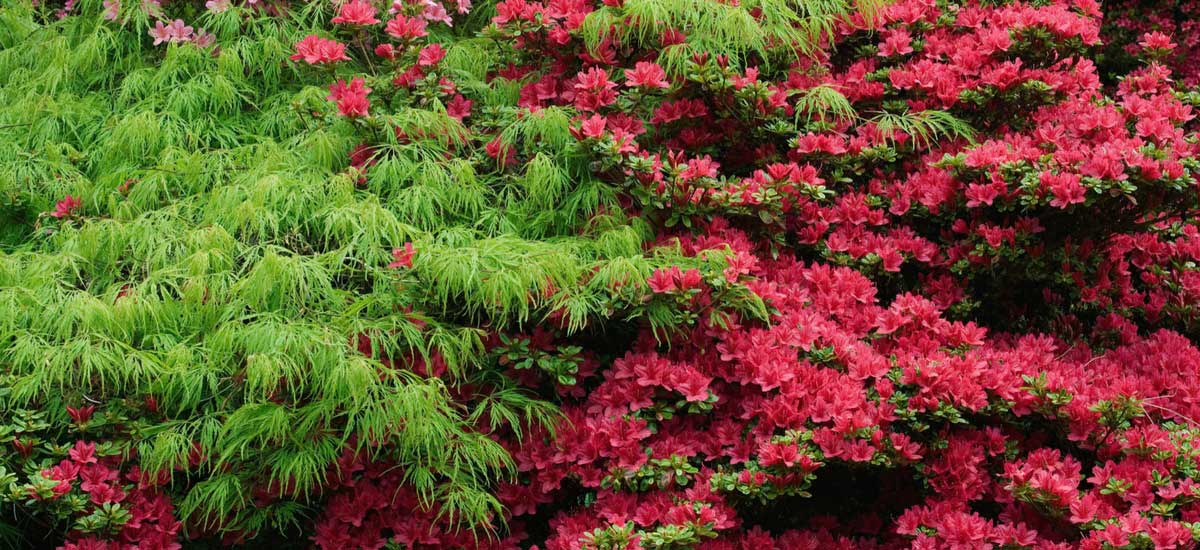
A pairing idea in heather soil: Acer palmatum and Rhododendron (Photo Credit GAP Dave Zubraski)
Japanese maple is particularly suited to city gardens. Create a contemporary garden, for example by placing it in a patio, planted in a container amidst a rather mineral and graphic decor. Add a few ferns, grasses, or ophiopogons.
Feel free to place your Japanese maple alongside other plants with decorative foliage: hostas, heucheras, ferns, grasses… Enjoy the stunning golden foliage of Hakonechloa macra ‘All Gold’. Japanese maples always pair wonderfully with ferns! Perhaps because these plants share a natural elegance and graphic quality. They impress us with the delicacy of their foliage, providing a sense of lightness and freshness.
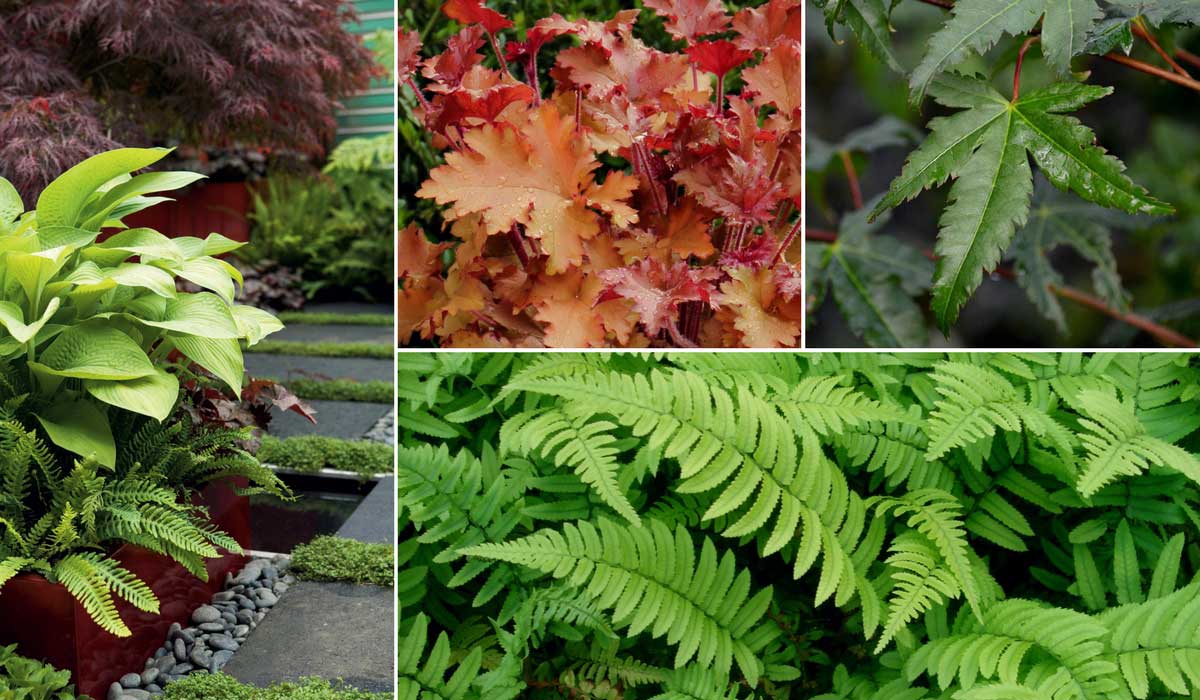
Acer palmatum ‘Garnet’ with Hosta ‘August Moon’, Heuchera ‘Pinot Noir’ and Blechnum spicant (Copyright GAP Photos-Sarah Cuttle), Heuchera ‘Marmalade’, Acer palmatum, Dryopteris cycadina.
You can play with colours, for example by creating beds in warm tones, with Acer palmatum ‘Sangokaku’, Heuchera ‘Marmalade’, and Persicaria runcinata ‘Purple Fantasy’. Enjoy the flamboyant foliage of the maple to create a stunning autumn scene! Plant alongside it plants like Eupatorium maculatum ‘Atropurpureum’, Sedum spectabile, a few dahlias, Cornus alba ‘Sibirica’, or the Indian Lilac (Lagerstroemia indica), whose foliage takes on beautiful hues in autumn. Don’t hesitate to highlight the colourful foliage of your maple among plants with darker shades, for example by planting Acer shirasawanum ‘Aureum’ next to heuchera ‘Obsidian’ or Sambucus nigra ‘Black Lace’… You will achieve a remarkable contrast!
Need a little extra inspiration? Visit our advice page: “Japanese Maples: 9 Ideas for Successful Pairings”
Did you know?
- An autumn spectacle in Japan!
In Japan, there is a custom of admiring the spectacle of leaves turning vibrant colours in autumn, particularly those of the Japanese Maples. This custom is called momijigari (momiji meaning Maple). The period of colour change for these leaves is referred to as kôyô. The best place to admire them is the Kyoto region, especially in certain temples. The maples are often illuminated to highlight their colours at night.
Useful resources
-
- Our wide range of maples, including many Japanese maples
- An article by Michael on our blog: Japanese Maples: Beware of Verticillium Wilt!
- Our advice sheets:
- The lesser-known maples
- atypical Japanese maples
- 7 variegated-leaf maples
- Frequently asked questions about Japanese maple: tips and answers
- Read: our advice sheets on Japanese maples by leaf colour: 6 Japanese maples with green leaves, 7 Japanese maples with red leaves, Japanese maples: the most beautiful autumn colours
Frequently asked questions
-
The foliage of my maple is drying and falling!
It is likely suffering from a lack of water. Japanese maple does not tolerate drought. Water during dry periods and mulch to keep the soil cool. It is essential to be very vigilant regarding watering, especially during the first few years. Afterwards, the bush becomes a bit more resilient. Similarly, if you are growing them in pots, the substrate will dry out quickly, and you will need to ensure regular watering. This may also be a sign of verticillium wilt, a fungal disease that is transmitted through the soil. Unfortunately, there is no curative treatment, only preventive measures, such as soil drainage during planting.
-
The branches of my maple have large black spots and are drying out. What should I do?
This is likely verticillium wilt, which causes necrosis and leads to the death of branches one by one. Unfortunately, there is no effective treatment for this disease. Immediately remove and burn the affected parts to limit its spread. We also advise you to thoroughly disinfect your pruning tools. Limit watering, especially if your maple is planted in the ground, and allow the soil to dry out between waterings, as moisture promotes the development of this disease.
-
The foliage shows signs of burning!
Your maple has likely been exposed to direct sunlight. It is better to place it in partial shade, preferably under deciduous trees. Light foliage is the most sensitive; it is more easily scorched than dark-leaved maples.
-
Autumn foliage is not exceptional; the colours are dull.
This happens when maples are planted in too dense a shade... the colours of the leaves fade! Just like with moisture, it's important to find the right medium: a bright situation but without too much direct sunlight. Partial shade is the exposure that suits them best.
-
My Japanese maple isn't shooting!
These are slow-growing trees and bushes. Please be patient. Otherwise, it is possible that your soil is too compact, which limits its development, or that the substrate is not rich enough! We recommend adding compost once a year.
- Subscribe!
- Contents
































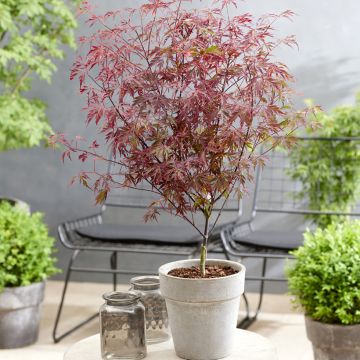

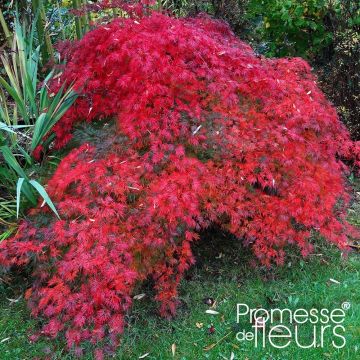
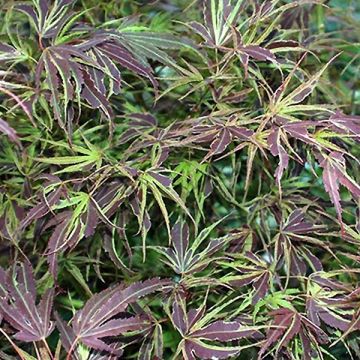



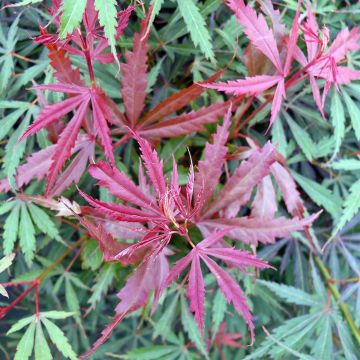
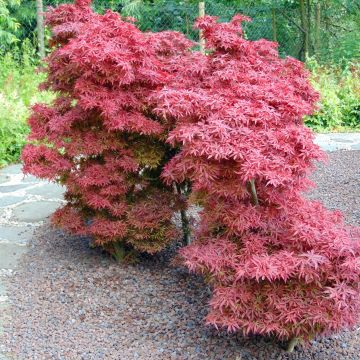
Comments